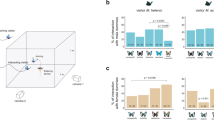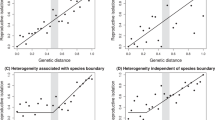Abstract
Theory suggests that natural selection against the production of unfit hybrids may reinforce barriers to gene flow, eventually leading to reproductive isolation of differentiated populations1,2,3,4. This mode of speciation may be achieved by female choice selecting for a divergence in male secondary sexual traits that facilitates species recognition. Although intuitively appealing, conclusive evidence for such reinforcement is generally lacking5,6,7,8, and serious doubts have been raised about its validity9,10,11. We have tested key predictions of the reinforcement hypothesis on the European, black-and-white, Ficedula flycatchers, using molecular techniques, field observations and mate choice experiments. In populations where two species coexist, we show that female choice selects for a divergence in male plumage colour and that the resulting character displacement reduces the frequency of hybridization.
This is a preview of subscription content, access via your institution
Access options
Subscribe to this journal
Receive 51 print issues and online access
$199.00 per year
only $3.90 per issue
Buy this article
- Purchase on Springer Link
- Instant access to full article PDF
Prices may be subject to local taxes which are calculated during checkout



Similar content being viewed by others
References
Dobzhansky, T. Speciation as a stage in evolutionary divergence. Am. Nat. 74, 312–321 (1940).
Dobzhansky, T. Genetics and the Origin of Species (Columbia Univ. Press, New York, (1941)).
Lewontin, R. C. The Genetic Basis of Evolutionary Change (Columbia Univ. Press, New York, (1974)).
Liou, L. W. & Price, T. D. Speciation by reinforcement of premating isolation. Evolution 48, 1451–1459 (1994).
Templeton, A. R. Mechanisms of speciation: a population genetic approach. A Rev. Ecol. Syst. 12, 23–48 (1981).
Butlin, R. Speciation by reinforcement. Trends Ecol. Evol. 2, 8–13 (1987).
Butlin, R. in Speciation and its Consequences (eds Otte, D. & Endler, J. A.) 158–179 (Sinauer, Sunderland, MA, (1989)).
Butlin, R. Reinforcement: an idea evolving. Trends Ecol. Evol. 10, 433–434 (1995).
Paterson, H. E. H. More evidence against speciation by reinforcement. S. Afr. J. Sci. 74, 369–371 (1978).
Spencer, H. G., McArdle, B. H. & Lambert, D. J. Atheoretical investigation of speciation by reinforcement. Am. Nat. 128, 241–262 (1986).
Sanderson, N. Can gene flow prevent reinforcement? Evolution 43, 1223–1235 (1989).
Lungberg, A. & Alatalo, R. V. The Pied Flycatcher (T. & A. D. Poyser, London, (1992)).
Røskaft, E. & Järvi, T. Interspecific competition and the evolution of plumage-colour variation in three closely related old world flycatchers Ficedula spp. J. Zool. (Lond.) 228, 521–532 (1992).
Sætre, G.-P., Král, M. & Bicˇík, V. Experimental evidence for interspecific female mimicry in Ficedula flycatchers. Evolution 47, 939–945 (1993).
Noor, M. A. Speciation driven by natural selection in Drosophila. Nature 375, 674–675 (1995).
Sætre, G.-P., Král, M. & Ims, R. A. Dynamics of a clinal hybrid zone and a comparison with island hybrid zones of flycatchers. Evolution(submitted).
Crosby, J. L. The evolution of genetic discontinuity: computer models of the selection of barriers to interbreeding between subspecies. Heredity 25, 253–297 (1970).
Caisse, M. & Antonovics, J. Evolution in closely adjacent plant populations. IX. Evolution of reproductive isolation in clinal populations. Heredity 40, 371–384 (1978).
Felsenstein, J. Skepticism toward Santa Rosalia or why are there so few kinds of animals Evolution 35, 124–138 (1981).
Lande, R. Rapid origin of sexual isolation and character divergence in a cline. Evolution 35, 213–223 (1982).
Zahavi, A. The cost of honesty (further remarks on the handicap principle). J. Theor. Biol. 67, 603–605 (1977).
Hamilton, W. D. & Zuk, M. Heritable true fitness and bright birds: a role for parasites? Science 218, 384–387 (1982).
Møller, A. P. Female swallow preference for symmetrical male sexual ornaments. Nature 357, 238–240 (1992).
Slagsvold, T. & Lifjeld, J. T. Plumage colour is a condition-dependent sexual trait in male pied flycatchers. Evolution 46, 825–828 (1992).
Sætre, G.-P., Fossnes, T. & Slagsvold, T. Food provisioning in the pied flycatcher: do females gain direct benefits from choosing bright-coloured males? J. Anim. Ecol. 64, 21–30 (1995).
Sætre, G.-P., Dale, S. & Slagsvold, T. Female pied flycatchers prefer brightly coloured males. Anim. Behav. 48, 1407–1416 (1994).
Andersson, M. Sexual Selection (Princeton Univ. Press, NJ, (1994)).
Felsenstein, J. PHYLIP: Phylogeny Inference Package, Version 3.5c (Univ. Washington, Seattle, (1993)).
Sætre, G.-P., Král, M. & Bureš, S. Differential species recognition abilities of males and females in a flycatcher hybrid zone. J. Avian Biol.(in the press).
Gustafsson, L., Qvarnström, A. & Sheldon, B. Trade-offs between life history traits and a sexually selected character in male collared flycatchers. Nature 375, 813–815 (1995).
Acknowledgements
We thank V. Bicˇík, O. H. Brekke, C. Chappuis, K. Clausen, E. Curio, B. Hallmann, K. Horáčková, K. Jakobsen, H. Källander, F. Krause, J. T. Lifjeld, J. Ormerod, M. Panayiotopoulou, T. Slagsvold and Y. Tsougrakis. Financial support was provided by the Norwegian Research Council.
Author information
Authors and Affiliations
Corresponding author
Rights and permissions
About this article
Cite this article
Stre, GP., Moum, T., Bureš, S. et al. A sexually selected character displacement in flycatchers reinforces premating isolation. Nature 387, 589–592 (1997). https://doi.org/10.1038/42451
Received:
Accepted:
Issue Date:
DOI: https://doi.org/10.1038/42451
This article is cited by
-
Phenology-mediated effects of phenotype on the probability of social polygyny and its fitness consequences in a migratory passerine
BMC Ecology and Evolution (2021)
-
The effect of phylogeographic history on species boundaries: a comparative framework in Hyla tree frogs
Scientific Reports (2020)
-
Variation in song structure along an elevation gradient in a resident songbird
Behavioral Ecology and Sociobiology (2020)
-
The role of claw color in species recognition and mate choice in a fiddler crab
Behavioral Ecology and Sociobiology (2020)
-
The evolution of reproductive isolation in Daphnia
BMC Evolutionary Biology (2019)
Comments
By submitting a comment you agree to abide by our Terms and Community Guidelines. If you find something abusive or that does not comply with our terms or guidelines please flag it as inappropriate.



